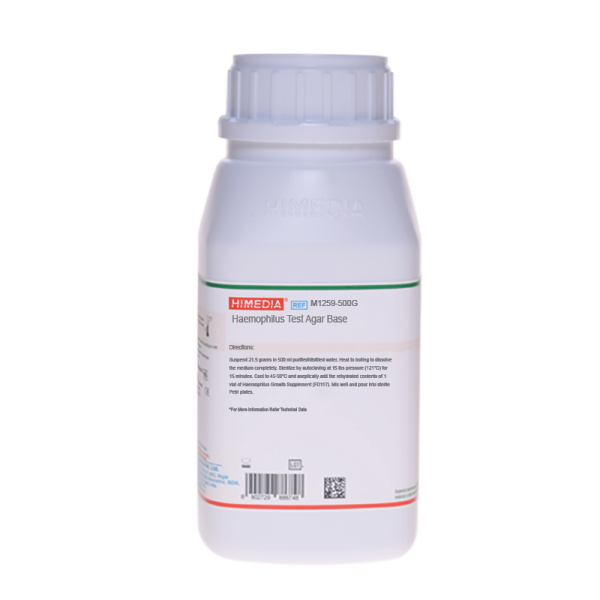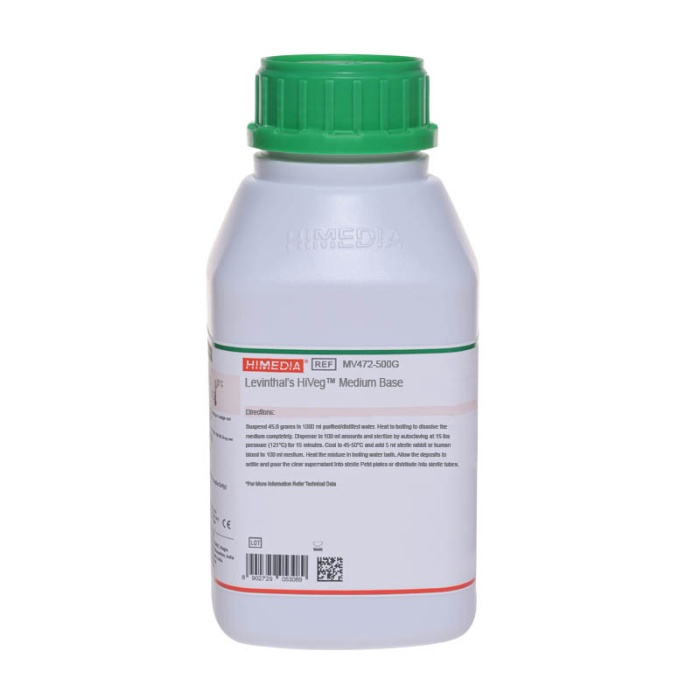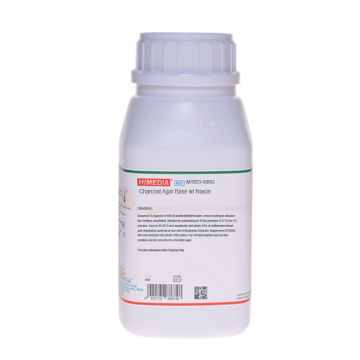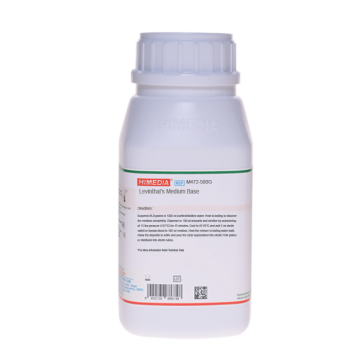 Your enquiry has been submitted
Your enquiry has been submitted
Haemophilus Test Agar Base
Intended Use:
Recommended for the susceptibility testing of Haemophilus influenzae.
Composition**
| Ingredients | Gms / Litre |
|---|---|
| HM infusion B from 300 g # | 2.000 |
| Acicaserm | 17.500 |
| Yeast extract | 5.000 |
| Starch | 1.500 |
| Agar | 17.000 |
Final pH (at 25°C): 7.4±0.2
**Formula adjusted, standardized to suit performance parameters
#- Equivalent to Meat infusion from
Directions
Suspend 21.5 grams in 500 ml purified/distilled water. Heat to boiling to dissolve the medium completely. Sterilize by autoclaving at 15 lbs pressure (121°C) for 15 minutes. Cool to 45-50°C and aseptically add the rehydrated contents of 1 vial of Haematin Growth Supplement (FD117). Mix well and pour into sterile Petri plates.
Principle And Interpretation
Haemophilus species are nutritionally fastidious in nature. They require either exogenous hemin (X-factor) or NAD (V-factor) or both (1). Due to this reason, Mueller Hinton Agar, which is used for antimicrobial susceptibility of bacteria (2,3,4), can't be used for the antimicrobial susceptibility testing of Haemophilus.
Also, addition of blood to Mueller Hinton Agar to supply the essential growth nutrients makes the medium opaque, rendering it unsuitable for antimicrobial susceptibility testing.
Haemophilus Test Agar Base, studied by Jorgensen et al (5,6) is used for the susceptibility testing of Haemophilus influenzae. This medium has similar composition as Mueller Hinton Agar, with the addition of yeast extract and added growth supplements. Haemophilus Test Agar Base is simple, transparent and posses minimum risk of antagonism of antimicrobial agents (5). Haemophilus Test Agar Base is also recommended by the United States National Committee for Clinical Laboratory Standards (NCCLS) for both dilution and disc diffusion assays. This medium scores over Mueller Hinton Agar with heamoglobin over clarity, thereby enabling proper visualization of inhibition zones. It also has low levels of the nucleotide thymidine, which allows testing of trimethoprim / sulphamethoxazole.
Haemophilus Test Agar Base contains HM infusion B from and Acicase™, which provide nitrogeneous and carbonaceous compounds, long chain amino acids and essential nutrients to the organisms. Yeast extract serves as a source of B complex vitamins. Starch acts as a protective colloid against toxic substances present in the medium. The surface of a Haemophilus Test Agar Base with added nutrients is inoculated either by using swab or by spreading the suspension. Antimicrobial discs i.e. paper discs impregnated with specific amount of antibiotics or other antimicrobial agents are placed on the surface of medium spaced properly. The plates are incubated in a CO2 incubator and subsequently the inhibition zones around each disc are read. Comparing the zones of inhibition with the NCCLS standards, the determination as to whether the organism is susceptible, resistant or intermediate in its response to the antimicrobial substances is made.
Type of specimen
Isolated Microorganism from clinical samples.
Specimen Collection and Handling:
The surface of a Haemophilus Test Agar Base with added nutrients is inoculated either by using swab or by spreading the suspension. Antimicrobial discs i.e. paper discs impregnated with specific amount of antibiotics or other antimicrobial agents are placed on the surface of medium spaced properly.
The plates are incubated in a CO2 incubator and subsequently the inhibition zones around each disc are read. Comparing the zones of inhibition with the NCCLS standards, the determination as to whether the organism is susceptible, resistant or intermediate in its response to the antimicrobial substances is made. After use, contaminated materials must be sterilized by autoclaving before discarding.
Warning and Precautions :
In Vitro diagnostic Use only. For professional use only. Read the label before opening the container. Wear protective gloves/protective clothing/eye protection/ face protection. Follow good microbiological lab practices while handling specimens and culture. Standard precautions as per established guidelines should be followed while handling clinical specimens. Safety guidelines may be referred in individual safety data sheets.
Limitations :
- The plates are to be incubated at 5-7% carbon dioxide at 35-37°C for 18-24 hours for appropriate results.
- Incorrect inoculum concentration may produce inaccurate results.
Performance and Evaluation
Performance of the medium is expected when used as per the direction on the label within expiry period when stored at the recommended temperature.
Quality Control
Appearance Cream to yellow homogeneous free flowing powder
Gelling Firm, comparable with 1.7% Agar gel
Colour and Clarity of prepared medium Light amber coloured, clear to slightly opalescent gel forms in Petri plates
Reaction Reaction of 4.3% w/v aqueous solution at 25°C. pH: 7.4±0.2
pH 7.20-7.60
Cultural Response
Cultural characteristics observed with added Haematin Growth Supplement (FD117) in 5-7% carbon dioxide after an incubation at 35-37°C for 18-24 hours.
| Organism | Inoculum (CFU) | Growth | Recovery |
|---|---|---|---|
| Haemophilus influenzae ATCC 49766 | 50-100 | luxuriant | >=70% |
| Enterococcus faecalis ATCC 29212 (00087*) | 50-100 | good-luxuriant | >=70% |
| Streptococcus pyogenes ATCC 19615 | 50-100 | good-luxuriant | >=70% |
| Neisseria meningitidis ATCC 13090 | 50-100 | good-luxuriant | >=70% |
| Staphylococcus aureus subsp. aureus ATCC 25923 (00034*) | 50-100 | good-luxuriant | >=70% |
Key: *Corresponding WDCM numbers.
Storage and Shelf Life
Store between 10-30°C in a tightly closed container and the prepared medium at 2-8°C. Use before expiry date on the label. On opening, product should be properly stored dry, after tightly capping the bottle in order to prevent lump formation due to the hygroscopic nature of the product. Improper storage of the product may lead to lump formation. Store in dry ventilated area protected from extremes of temperature and sources of ignition. Seal the container tightly after use. Product performance is best if used within stated expiry period.
Disposal
User must ensure safe disposal by autoclaving and/or incineration of used or unusable preparations of this product. Follow established laboratory procedures in disposing of infectious materials and material that comes into contact with clinical sample must be decontaminated and disposed of in accordance with current laboratory techniques (7,8).
Reference
- Murray P. R., Baron J. H., Pfaller M. A., Jorgensen J. H. and Yolken R. H., (Ed.), 2003, Manual of Clinical Microbiology, 8th Ed., American Society for Microbiology, Washington, D.C.
- Barry A. L., Garcia F., and Thrupp L. D., 1970, Am. J. Clin. Pathol., 53 :149.
- Bauer A. W., Kirby W. M., Sherris J. C. and Turck M., 1966, Am. J. Clin. Pathol. 45:493.
- Ryan K. J., Schoenknecht F. D., and Kirby W. M., 1970, Hospital Practice, 5:91.
- Jorgensen J. H., Redding J. S., Maher L. A. and Howell A. W., 1987, J. Clin. Microbiol., 25:2105.
- Jorgensen J. H., Howell A. W., and Maher L. A., J. Clin. Microbiol, 28:985.
- Isenberg, H.D. Clinical Microbiology Procedures Handbook 2nd Edition.
- Jorgensen, J.H., Pfaller, M.A., Carroll, K.C., Funke, G., Landry, M.L., Richter, S.S and Warnock., D.W.(2015)Manual of Clinical Microbiology, 11th Edition. Vol. 1.
| Product Name | Haemophilus Test Agar Base |
|---|---|
| SKU | M1259 |
| Product Type | Regular |
| Physical Form | Powder |
| Origin | Animal |
| Packaging type | HDPE |
| References | 1. Barry A. L., Garcia F., and Thrupp L. D., 1970, Am. J. Clin. Pathol., 53 :149. |
| Customized Product Available | No |











